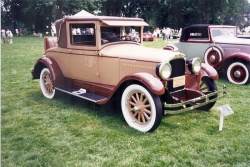 1927 Pontiac. Click image to enlarge |
Article and photos by Bill Vance
Although there were a few high-wheeler Pontiacs manufactured early in the twentieth century by the Pontiac Spring and Wagon Works of Pontiac, Michigan, before the General Motors Pontiac, it was the GM product that prevailed. Produced for over 80 years, it was part of the hierarchy of cars that made GM the world’s mightiest corporation. Pontiac dated from 1926 but its roots went back to the establishment of Oakland Motor Car Company in Pontiac, Michigan 1907.
Carriage entrepreneur Billy Durant founded General Motors in 1908 and acquired Oakland in 1909. Oakland had bowed with a two-cylinder engine but soon advanced to a four, then a six and even a short-lived V8 in 1916. When the legendary Alfred P. Sloan, Jr. assumed GM’s presidency in 1923 and reviewed its stable of cars, Oakland was an average sales performer slotted between Chevrolet and Buick.
In 1926, Oakland introduced the Pontiac, a companion car that it hoped would boost sales by offering a little more than the Chevrolet at only a slightly higher price. It was based on the Chevrolet chassis, but unlike the Chevrolet’s four it got a sturdy new short-stroke, side-valve six producing a modest 40 horsepower at only 2,400 r.p.m. It was a very durable engine and Pontiac sold an industry leading 76,000 in its first year, all closed models, reflecting the rapid trend to closed cars started in 1925 when closed cars sales overtook open ones. The audacious newcomer outsold its Oakland parent.
Both Oakland and Pontiac continued, but as Pontiac sales soared Oakland’s days became numbered. Its end came in 1931 when Pontiac became the only companion car to replace its parent. Using many Chevrolet parts made Pontiac the lowest priced six on the market, and inaugurated the mix-and-match component policy used by GM for decades.
Pontiac flourished during the 1930s offering solid if unspectacular cars. It got such GM advances as “Turret Top” all-steel construction, Dubonnet “Knee Action” front suspension and four-wheel hydraulic brakes. Its distinctive “Silver Streak” hood and deck stripes appeared in 1935. A sound reputation for good value secured its GM niche and by 1941 before the Second World War American car production shut-down, Pontiac’s close to 300,000 sales stood fifth in the industry.
After the war, Pontiac returned with warmed over ’42 models until new ones came in 1949. Reliable six and straight-eight side-valve engines, automatic transmissions and appealing styling kept sales brisk, if often to older buyers.








